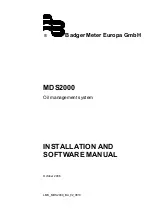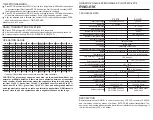
Installation, Operation and Maintenance
Solenoid (On-Off) Control Valve with Hydraulic Check Feature (4" and
Smaller)
Sizes: 11/4" to 4"
NOTICE
For Australia and New Zealand: Pipeline strainers should be
installed between the upstream shutoff valve and the inlet of
the backflow preventer.
It’s important that this device be tested periodically in compli-
ance with local codes, but at least once per year or more as
service conditions warrant. If installed on a fire sprinkler system,
all mechanical checks, such as alarm checks and backflow
preventers, should be flow tested and inspected internally in
accordance with NFPA 13 and NFPA 25.
WARNING
!
Read this Manual BEFORE using this equipment.
Failure to read and follow all safety and use information
can result in death, serious personal injury, property
damage, or damage to the equipment.
Keep this Manual for future reference.
Table of Contents
Page
Introduction . . . . . . . . . . . . . . . . . . . . . . . . . . . . . . . . . . . . . . . . . . . . 2
Installation . . . . . . . . . . . . . . . . . . . . . . . . . . . . . . . . . . . . . . . . . . . . 2
Setting the Solenoid Control Valve . . . . . . . . . . . . . . . . . . . . . . . . . . 3
Maintenance Schedule . . . . . . . . . . . . . . . . . . . . . . . . . . . . . . . . . . . 6
Trouble Shooting Guide . . . . . . . . . . . . . . . . . . . . . . . . . . . . . . . . . . 6
Valve Disassembly Instructions . . . . . . . . . . . . . . . . . . . . . . . . 8
ACV Schematic . . . . . . . . . . . . . . . . . . . . . . . . . . . . . . . . . . . . . . . 11
Local building or plumbing codes may require modifica-
tions to the information provided. You are required to
consult the local building and plumbing codes prior
to installation. If the information provided here is not
consistent with local building or plumbing codes, the
local codes should be followed. This product must be
installed by a licensed contractor in accordance with
local codes and ordinances.
WARNING
!
Need for Periodic Inspection/Maintenance:
This product
must be tested periodically in compliance with local codes,
but at least once per year or more as service conditions
warrant . All products must be retested once maintenance
has been performed . Corrosive water conditions and/or
unauthorized adjustments or repair could render the product
ineffective for the service intended . Regular checking and
cleaning of the product’s internal and external components
helps assure maximum life and proper product function .
WARNING
!
Model LFM113-25 / LFM6113-25
IOM-ACV-113-25_6113-25






























